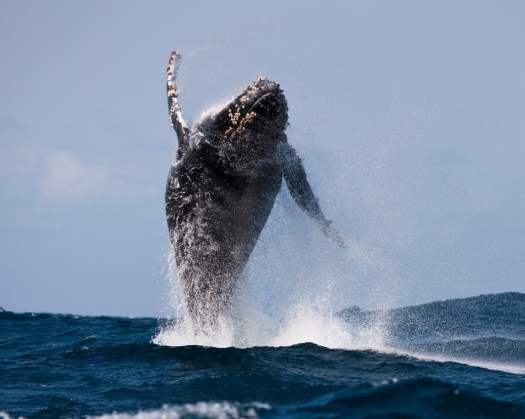A humpback whale has set a remarkable record by traveling across at least three oceans and covering over 8,000 miles, likely in pursuit of a mate, as revealed by a recent study.
Researchers tracked the adult male whale, which journeyed 8,106 miles from its breeding grounds in Colombia, South America, to those in Zanzibar, Africa, between 2013 and 2022.
This extraordinary journey marks the longest distance ever recorded for the species and is detailed in a study published on Wednesday in the journal Royal Society Open Science, offering potential new perspectives on the migration patterns and behaviors of humpback whales.
The findings indicate that both mating and environmental factors may have played a role in the whale's extensive journey.
The research team utilized images from Happywhale, an online platform that gathers photos of whale flukes from scientists and the public worldwide. This platform employs artificial intelligence-driven photo-matching algorithms to assist in the automatic identification of whales in the submitted images, with matches subsequently verified or rejected by data managers, according to the study.
The whale was initially photographed in July 2013 off the Colombian coast in the Pacific Ocean, where it was observed within a "competitive group" consisting of seven humpbacks.
This same whale was later photographed in 2022 in the southwest Indian Ocean near Zanzibar, a distance of 8,106 miles from its original sighting nine years prior.
Researchers initially suspected a mistake had occurred. "The immediate reaction was, 'This is a mistake. One of these photos is out of place,'" stated Ted Cheeseman, co-founder of Happywhale and a co-author of the study.
However, it was confirmed to be the same whale. Scientists identified it as a male due to its active participation in mating pods and a photograph of its genital area, as noted in the study.
According to NOAA Fisheries, humpback whales exhibit one of the longest migration patterns of any mammal, with some populations traveling up to 5,000 miles from tropical breeding areas to colder feeding grounds.
What was particularly remarkable about this whale's journey was its crossing of multiple populations from its starting point in South America to its most recent sighting in Africa, Cheeseman explained. Notably, it undertook this journey as an adult.
"By the time humpback whales reach adulthood, they typically follow very fixed and consistent migration patterns," Cheeseman remarked. "This whale, however, exhibited entirely different behavior."
Researchers have previously noted instances of humpback whales deviating from their usual migration routes. However, the whale examined in the Royal Society Open Science study stands out due to the remarkable distance it traveled, achieving a record for the longest documented great-circle distance, which represents the shortest route between two locations.
The scientists remain uncertain about the specific reasons behind the whale's chosen path. The study proposes that factors such as climate change and other environmental shifts may have influenced this behavior, along with the quest for food. Additionally, the paper suggests that increasing population density could result in heightened competition among males, prompting them to venture further in search of sustenance and mates.
Olaf Meynecke, a marine scientist and manager of the Whales and Climate research program at Griffith University in Australia, who was not involved in the study, noted that the research primarily focuses on a single whale's movement across different populations, a phenomenon previously documented.
Meynecke emphasized the value of analyzing multiple individuals rather than concentrating on just one whale. He expressed a greater interest in the broader implications of larger data sets, especially with advancements in facial and fluke recognition technology.
“This demonstrates the sophistication of our data collection methods,” he remarked. “Automated fluke recognition significantly enhances our ability to identify individuals and gain deeper insights into their movement patterns.”
Gaining insights into the behavior and movement patterns of various species is enlightening, particularly in the case of humpback whales, whose populations have significantly recovered in recent decades after suffering severe declines due to commercial whaling. However, this resurgence is occurring alongside various changes in the ocean environment, as noted by Cheeseman. “This creates potential for unexpected developments.”
Furthermore, the research underscores the importance of ocean conservation and protection.
“There is no humpback whale in the world that resides solely within the waters of a single nation,” Cheeseman emphasized. “These are international and shared waters, and as researchers and members of a community invested in ocean health, we must manage and safeguard them as interconnected marine environments.”








